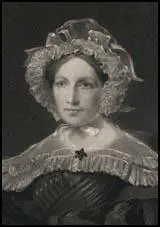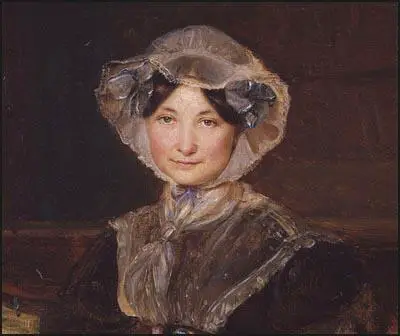Frances Trollope

Frances (Fanny) Milton, the middle child of William Milton (1743–1824), and his first wife, Mary Gresley Milton, was born in Bristol on 10th March 1779. Her father was the vicar of Heckfield, Hampshire. According to Pamela Neville-Sington the author of Frances Trollope (1998): "William Milton... preferred inventing gadgets to saving souls, and his most important idea was the creation of a tidal bypass to control the water levels of the Avon, allowing ships to sail in and out of Bristol more freely. Of his three children, Frances - or Fanny as she was known to her friends and family - resembled her father most. Like him, she was incapable of sitting still and doing nothing if there was a problem to be solved or a situation to be improved. Without the guidance of her mother, who died when Fanny was only five or six years old, she also learned to be self-reliant. Together these traits - initiative, tenacity, and independence of mind - were to give her the courage, strength, and ability to overcome the many crises which she would have to face in her lifetime; but they also made her sometimes act rashly, without thinking, and thus court disaster."
In 1800 her father married Sarah Partington. Fanny did not like her stepmother and along with her sister, Mary, decided to live with her brother Henry in London. When she was twenty-nine she met the barrister, Thomas Trollope. He considered her to have a petite figure, a pleasant face, and "the neatest foot and ankle" on the dance floor. After a year's courtship, they married on 23rd May 1809. Her first child died soon after being born. Over the next nine years Fanny gave birth to six more children: Thomas, Henry, Arthur, Anthony, Cecilia, and Emily.
Thomas later recalled: "My mother's disposition… was of the most genial, cheerful, happy, enjoué nature imaginable… and to any one of us a tête-à-tête with her was preferable to any other disposal of a holiday hour". By contrast, Thomas Anthony, was a harsh father and used to punish the children for small misdemours by pulling their hair. It has been speculated that his agrressive behaviour was caused by the effects of calomel, a mercury-based drug which he took for chronic migraine.
Thomas Trollope eventually took over a 160 acre farm. He had no experience in farming and he was soon heavily in debt. Thomas Trollope's son, Anthony Trollope, said that everything his father touched ended in failure: "But the worse curse to him of all was a temper so irritable that even those he loved the best could not endure it. We were all estranged from him, and yet I believed he would have given his heart's blood for any of us. His life as I knew it was one long tragedy."
In 1827 Frances and her two daughters spent time visiting Frances Wright at Nashoba, a community in the backwoods of Tennessee dedicated to the education and emancipation of slaves. According to her biographer, Pamela Neville-Sington: "Fanny thought it Henry's best chance to find a good prospect in life; she also hoped to ease the family's financial burdens back home while escaping her husband's dreadful temper. She left her two remaining sons, Tom and Anthony, at home to continue their education. When her friend's utopian dream turned out to be a malaria-ridden swamp, Fanny decamped and headed up the Mississippi to Cincinnati, Ohio."
While living in Cincinnati, Frances Trollope opened up what has been called "America's first shopping mall", the Cincinnati Bazaar. The venture was a disaster and see ended up bankrupt and ill with malaria. She began spending a great deal of time with a young French artist, Auguste Hervieu, who, despite the gossip, was in fact nothing more than a devoted friend. In August 1831 she returned to England.
The following year she published Domestic Manners of the Americans (1832). The book was an attack of what she believed was the hypocrisy of the Americans. "With one hand hoisting the cap of liberty, and with the other flogging their slaves. You will see them one hour lecturing their mob on the indefeasible rights of man, and the next driving from their homes the children of the soil, whom they have bound themselves to protect by the most solemn treaties."

Thomas Trollope, still heavily in debt, died in 1835. Frances Trollope decided to become a novelist. Her novels were very popular and it was not long before she was able to pay off her husband's debts. Trollope believed that novels should deal with important social issues. Her novel, Jonathan Jefferson Whitlaw, was about the evils of slavery, and The Vicar of Wrexhill tackled the subject of church corruption.
In 1839 Frances Trollope decided to write a novel on young factory workers. She had become interested in the subject after reading a copy of the book on the life of Robert Blincoe in 1832. Before writing the novel she carried out a fact-finding mission to Manchester. Frances Trollope was accompanied by the French artist, Auguste Hervieu, who had been commissioned to produce illustrations for the book. Trollope and Hervieu spent several weeks visiting factories and having meeting with people involved in the campaign for factory reform. This included Richard Oastler, Joseph Raynor Stephens and John Doherty, the editor of The Poor Man's Advocate .
The first part of Michael Armstrong: Factory Boy, was published in 1840. Frances Trollope was the first woman to issue her novels in monthly parts. Costing one shilling a month, it was also the first industrial novel to be published in Britain. The conservative The Athenaeum, gave it a hostile reception and compared Trollope to James Rayner Stephens: "The most probable immediate effect of her pennings and her pencillings will be the burning of factories and the plunder of property of all kinds. The Rev. James Rayner Stephens has recently been sentenced to eighteen months imprisonment for using seditious and inflammatory language. The author of Michael Armstrong deserves as richly to have eighteen months in Chester Gaol. But if the text be bad, still worse are the plates that illustrate it. What, for instance, must be the effect of the first picture in No. V1 (mill children competing with pigs for food), on the heated imaginations of our great manufacturing towns, figuring as they do in every book-seller's window."
in Francis Trollope's Michael Armstrong (1840)
Richard Henry Horne, the author of A New Spirit of the Age (1844) also disliked her novels: "Mrs Trollope takes a strange delight in the hideous and revolting. Nothing can exceed the vulgarity of Mrs Trollope's mob of characters. We have heard it urged on behalf of Mrs. Trollope that her novels are, at all events, drawn from life. So are sign paintings."
Of her novels, The Widow Barnaby and The Widow Married were the most successful. Pamela Neville-Sington has argued: "In her later novels, whether set in a cathedral town, a country estate, or London's West End, Fanny combined witty social commentary with strong and often melodramatic plots. At its best, Fanny's writing is subtle and well observed and, even in the most far-fetched romance, she is able to convey with great skill the foibles and follies of human nature - and of English manners in particular. She astutely aimed to hit the somewhat lowbrow taste of the circulating library."
By the time Frances Trollope died in Florence on 6th October 1863, aged eighty-four, she had written forty books. Her sons, Anthony Trollope (1815-1882) and Thomas Adolphus Trollope (1810-1892), were both successful writers.
Primary Sources
(1) Frances Trollope, Domestic Manners of the Americans (1832)
With one hand hoisting the cap of liberty, and with the other flogging their slaves. You will see them one hour lecturing their mob on the indefeasible rights of man, and the next driving from their homes the children of the soil, whom they have bound themselves to protect by the most solemn treaties.
(2) Frances Trollope, Michael Armstrong, the Factory Boy (1840)
A little girl about seven years old, who job as scavenger, was to collect incessantly from the factory floor, the flying fragments of cotton that might impede the work... while the hissing machinery passed over her, and when this is skillfully done, and the head, body, and the outstretched limbs carefully glued to the floor, the steady moving, but threatening mass, may pass and repass over the dizzy head and trembling body without touching it. But accidents frequently occur; and many are the flaxen locks, rudely torn from infant heads, in the process.
(3) Frances Trollope, Michael Armstrong, the Factory Boy (1840)
In the room they entered, the dirty, ragged miserable crew, were all active performance of their various tasks; the overlookers, strap in hand, on the alert; the whirling spindles urging the little slaves who waited on them. Lean and distorted limbs - sallow and sunken cheeks - dim hollow eyes... a look of hideous premature old age.
(4) In his autobiography, What I Remember, Thomas Adolphus Trollope described his mother and himself meeting a group of men in Manchester campaigning against child labour.
Nearly all of them, men a little raised above the position of the factory hands, to the righting of whose wrongs they devoted their lives. They had been at some period of their lives, in almost every case, factory workers themselves, but had by various circumstances, native talent, industry and energy managed to raise themselves out of the slough of despond in which their fellows were overwhelmed. John Doherty came to dine but his excitement in talking was so great and continuous that he could eat next to nothing.
(5) Richard Henry Horne, A New Spirit of the Age (1844)
Mrs Trollope takes a strange delight in the hideous and revolting. Nothing can exceed the vulgarity of Mrs Trollope's mob of characters. We have heard it urged on behalf of Mrs. Trollope that her novels are, at all events, drawn from life. So are sign paintings.
(6) The Athenaeum (1839)
The most probable immediate effect of her pennings and her pencillings will be the burning of factories and the plunder of property of all kinds. The Rev. James Raynor Stephens has recently been sentenced to eighteen months imprisonment for using seditious and inflammatory language. The author of Michael Armstrong deserves as richly to have eighteen months in Chester Gaol. But if the text be bad, still worse are the plates that illustrate it. What, for instance, must be the effect of the first picture in No. V1 (mill children competing with pigs for food), on the heated imaginations of our great manufacturing towns, figuring as they do in every book-seller's window.

